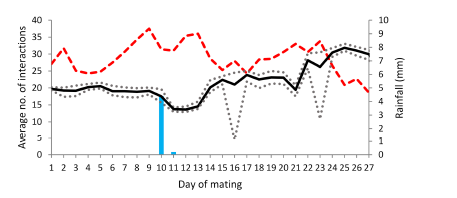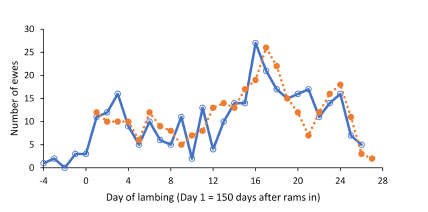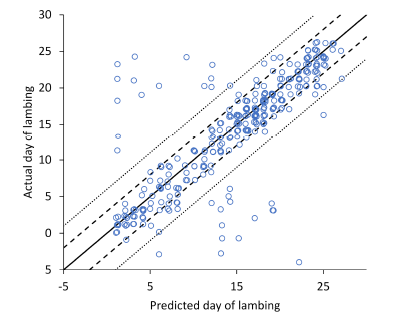Predicting lambing dates using ewe-ram interactions
Kirsty Cunningham, Andrew Van Burgel, Claire Macleay, Beth Paganoni (DPIRD, WA); Khama Kelman and Andrew Thompson (Murdoch University, WA)
Author correspondence: Kirsty.Cunningham@dpird.wa.gov.au
Introduction
Lamb mortality is an economic and welfare issue for sheep producers in Australia. In Australia, about 25% of all lambs born will die, with over 80% of deaths occurring within three days after birth. Mortality rates are higher in multiple born lambs, compared to single born lambs (Oldham et al 2011, Hinch and Brien 2014, Refshauge et al 2016).
Lamb mortality can be reduced by improving ewe nutrition during pregnancy, increasing feed on offer (FOO), reducing mob size, and providing shelter during lambing. However, implementing these strategies on extensively grazed farms is often limited due to feed supply, large paddock sizes, access to sheltered paddocks suitable for lambing, and the spread of lambing dates.
The average mating period for Merino producers is almost 8 weeks (Sloane 2018, Jones and Reed 2017, Bunter et al 2018), resulting in a large spread in potential lambing dates making it difficult to maintain ewe condition score and feed on offer targets over these extended lambing periods. This can result in the condition and lambing environment potentially being suboptimal for ewes that conceive later during mating. Accurate prediction of lambing dates allows ewes with similar gestational ages to be managed to achieve targets and improve lamb survival.
On-animal sensor systems that measure changes in ewe–ram behaviours and interactions during the mating period offer potential for improving the prediction of lambing dates. This study aimed to predict lambing dates using proximity sensors for larger numbers of ewes joined with multiple rams in commercial production-sized paddocks. We reasoned that by measuring the interactions between ewes and rams during mating, as an indicator of time of oestrus, we can predict the lambing dates of ewes.
Key findings
- Use of proximity sensors identified the time of oestrus from ewe–ram interactions during mating. This allowed precise lambing date predictions assuming a gestation period of 150 days.
- The capacity to predict lambing dates will enable farmers to:
- Precisely manage cohorts of ewes with similar gestational ages during mid and late pregnancy and lambing
- Optimise ewe nutrition, lamb birthweights, access to shelter and mob sizes to increase the overall survival of lambs.
- Proximity sensors could not be used to indicate the sire of the progeny.
Materials and methods
Animals
Four hundred and sixteen maiden Merino ewes (born 2019) were mated with nine adult (2016-drop, experienced, testicles in-tact) Merino rams in 2021 on a dry cereal stubble (50 ha) for 35 days at the Katanning Research Facility.
All ewes and rams were fitted with proximity sensors and grazed together over the mating period. At 58 days, ewe pregnancy status was identified by scanning.
Sensors
GT3X v4.4.0 sensors (ActiGraph, Pensacola, FL, USA) were used to measure proximity via Bluetooth. Interactions between the ewes and rams were recorded at 30 hz over an approximate 1–15 m range every minute. A maximum of ten interactions per sensor were recorded each minute (e.g., 10 ewes within range of a ram equals 10 ewe/ram interactions; if there were more than ten ewes within about 15 m of the ram then the ten closest ewes to the ram were recorded for that minute).
Data analysis
Lamb birth dates were predicted from the ewe’s date of peak interactions (predicted date of oestrous) expressed for each ewe by a “Maximum daily interactions ratio”. The ratio (for each day and ewe combination) is calculated as the number of interactions between the ewe and all rams divided by the average number of interactions for all ewes on that day.
A gestation length of 150 days was used for all ewes as per the methods of Paganoni et al (2020), where gestation length was defined as the number of days between mating and lamb birth.
Results
Ewe and ram Interactions during the mating period
On average, a ram interacted with a ewe 22 times a day over the first 27 days of the mating period, with the average number of interactions ranging from 13 times a day (excluding battery failures) to 33 times a day. The average number of interactions increased over time, peaking at day 25 (Figure 1). Short term declines in interactions were observed on days 10–13 and 21. A reduction in the minimum number of interactions achieved per ram/day occurred on day 16 and day 23 of mating, respectively, due to partial data capture for two rams. On any given day, the variation in the average number of interactions for individual rams was small (approximately five), representing no distinct differences in social behaviour between rams.

Distribution of lambing date
Lambing commenced on 5 June (day 4) and ended on 5 July (day 26). A total of 429 lambs were born including 206 singles and 223 multiples (from 111 ewes). The greatest number of lambs were born on day 16 (n = 27) (Figure 2, solid line).

Predicting lambing date
The predicted lambing date was within ±3 and ±6 days of the actual lambing date for 84% and 91% of the ewes, respectively (Figure 3). There was no significant difference in accuracy for single bearing verses multiple bearing ewes.

The maximum number of daily interactions for a single ewe ranged from 244 interactions/day to 1457 interactions/day. The percentage of lambing dates predicted correctly increased as the number of interactions between rams and ewes increased (Table 1).
Table 1: The percentage of predicted lambing date within 3 and 6 days of the actual lambing date for different ranges of maximum daily interactions ratio.
| Maximum Daily Interactions Ratio | Number of Ewes | Accuracy | |
| +/- 3 Days | +/- 6 Days | ||
| >3 | 1.4 | 94% | 99% |
| 2.5-3 | 62 | 90% | 97% |
| 2-2.5 | 69 | 83% | 88% |
| 1.5-2 | 59 | 73% | 85% |
| <1.5 | 23 | 52% | 57% |
| All | 317 | 84% | 91% |
Gestation length
The prediction accuracy was the highest for a gestation length of 149 or 150 days and either of these would be an acceptable choice. Prediction accuracy decreases substantially (at ±1 and ±3 days) when the gestation length is reduced to 148 days or increased to 151 days.
DNA results
The ram with maximum interactions on the estimated day of conception was only the successful sire for 16% of lambs born. Two rams were more dominant, siring 61% of all lambs born. One ram did not sire any progeny and another two sired only 3 lambs each (1%).
Discussion
Using proximity sensors to identify the time of oestrus from ewe–ram interactions during mating, and assuming a gestation period of 150 days allowed us to precisely predict the lambing date of Merino ewes under commercial production conditions. In all, 84% and 91% of actual lambing dates for all ewes were predicted within ±3 and ±6 days, respectively. The results therefore support the hypothesis that measuring ewe–ram interactions during the mating period can predict lambing dates precisely for ewes run under commercial production conditions. The capacity to predict lambing dates will enable farmers to manage cohorts of ewes with similar gestational ages precisely during mid and late pregnancy and lambing. Management of ewe nutrition, lamb birthweights, access to shelter and mob sizes can be optimised to increase the overall survival of lambs. Lambing cohorts of ewes over 7 to 13 days (±3 to ±6) could also increase the practicality of strategies to improve lamb survival, such as simplifying the management and marketing of lambs that are more uniform for age and weight. Finally, as described by Paganoni et al. (2020), more precise estimates of lambing date and hence lamb age could also improve the accuracy of estimated breeding values, especially those relating to early life growth potential.
Lamb birth dates were predicted from the day on which the ewe had the highest ratio of interactions. Initially a ewe’s maximum daily interactions ratio was calculated based on the interactions of the ewe with individual rams. However, this method was less accurate, and the DNA parentage data showed the ram corresponding with the maximum daily interactions ratio was the sire for only 16% of all progeny. This suggests that the ewes mated typically with multiple rams during oestrus, which is not entirely surprising given that Clarke et al (2021) recently reported than more than 50% of multiple born lambs from syndicate mated Merino ewes were from different sires. Our results were similar, with 37% of multiple born lambs having differing sires. We therefore concluded that, whilst proximity sensors could accurately predict the time of lambing, they could not be used to indicate the sire of the progeny.
The present study, together with Paganoni et al (2020), indicate that using proximity sensors to identify the time of conception to predict the time of lambing is likely to be less variable and more accurate than other methods, such as foetal aging using transabdominal ultrasound scanning. In contrast, the accuracy of predicting time of lambing using proximity sensors was not influenced by litter size. Given that multiple born lambs are more vulnerable to the effects of ewe nutrition, birthweight, mob size and shelter, using proximity sensors could benefit the management of multiple bearing ewes both pre- and post-lambing.
Conclusion
This study confirms that sensors to determine the proximity between ewes and rams during mating can be used to accurately identify the time of oestrus in ewes and therefore predict lambing dates under commercial production conditions. This method offers considerable advantages in comparison to current methods to predict lambing dates, such as foetal ageing, in that it is not reliant on operator skill and is less sensitive to litter size. The capacity to predict lambing dates will enable farmers to manage cohorts of ewes with similar gestational ages to be managed more precisely during late pregnancy and lambing to improve overall survival of lambs, as well as opportunities to improve lamb performance and the accuracy of breeding values. Further improvements in prediction accuracy may be achieved when mating older, multiparous ewes in smaller mating paddocks.
Full Paper
Acknowledgements
The authors acknowledge the technical assistance of staff members at the Department of Primary Industry and Regional Development’s Katanning Research Facility, and Australian Wool Innovation for use of the ActiGraph GT3X sensors.
References
Bunter K, Smith J and Fowler D (2018), ‘How accurate is foetal aging at pregnancy scanning to predict lambing date?’ Proceedings of the Australian Society of Animal Production, 58, cxiv.
Clarke BE, Egerton-Warburton KL, Smith JL, Paganoni B, Martin G and Thompson, AN (2021), ‘Split paternity is high in twins born from syndicate-mated merino ewes’, Proceedings of the Australian Society of Animal Breeding and Genetics, vol 24, pp 54–57.
Hinch GN and Brien F (2014), ‘Lamb survival in Australian flocks: A review’, Animal Production Science, vol. 54, pp. 656–666.
Hocking-Edwards JE, Copping KJ and Thompson AN (2011) ‘Managing nutrition of twin bearing ewes during pregnancy using Lifetimewool recommendations increases production of twin lambs’, Animal Production Science, vol. 51, pp. 813–820.
Jones AK and Reed SA (2017), ‘Benefits of ultrasound scanning during gestation in the small ruminant’, Small Ruminant Research, vol. 149, pp. 163–171.
Lockwood A, Hancock S, Kearney G and Thompson AN (2019), ‘Reducing mob size increases the survival of twin-born Merino lambs when feed-on-offer from pasture is limited and ewes are supplementary fed during lambing’, Small Ruminant Research, vol. 173, pp. 65-69.
Oldham CM, Thompson AN, Ferguson MB, Gordon D, Kearney GA, Paganoni BL (2011), ‘The birthweight and survival of Merino lambs can be predicted from the profile of liveweight change of their mothers during pregnancy’, Animal Production Science, vol. 51, pp. 776–783.
Paganoni B, Macleay C, van Burgel A and Thompson A (2020), ‘Proximity sensors fitted to ewes and rams during joining can indicate the birth date of lambs’, Computers and Electronics in Agriculture, vol. 170, pp. 105249.
Refshauge G, Brien FD, Hinch GN and van de Ven R (2016), ‘Neonatal lamb mortality: Factors associated with the death of Australian lambs’, Animal Production Science, vol. 56, pp. 726–735.
Sloane R (2018), Australian Wool Innovation 2017 Merino Husbandry Practices Survey; Australian Wool Innovation Ltd.: Sydney, Australia.
